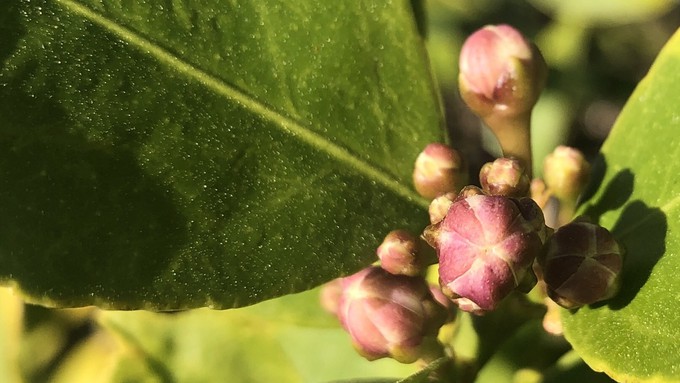
Warmer days are enticing for tomato planting

These buds on a Meyer lemon tree will be blooming soon, a reminder that the tree will need a low dose of fertilizer to help set fruit. Kathy Morrison
“Can I plant my tomatoes now?”
After a very cool spring, gardeners throughout the Sacramento region are voicing that same concern. It may seem late, but actually nature is right on schedule.
Traditionally, tomato planting time in Sacramento is late April and the first two weeks of May. Even though air temperature is warming, soil temperature is staying chilly. And we’re in for a few more sub-par days.
According to the National Weather Service, Sacramento will be back in the low 60s Monday through Wednesday. The possibility of rain is minimal (less than 5%), but it will be breezy, especially Tuesday evening. Overnight lows will nudge 40 degrees on Tuesday and Wednesday.
The good news: Our spring warm-up is coming soon. We’ll be comfortably back in the 70s by Friday. Even better, overnight lows will warm up 10 degrees, too – much better for newly transplanted tomatoes.
So, if you can wait a week or two, your tomatoes will be much happier in their new homes. And happy tomatoes grow faster and healthier.
Meanwhile, take care of these other garden tasks:
* April is the last chance to plant citrus trees such as dwarf orange, lemon and kumquat.
* Smell orange blossoms? Feed citrus trees with a low dose of balanced fertilizer (such as 10-10-10) during bloom to help set fruit. Keep an eye out for ants; they bring aphids.
* Apply slow-release fertilizer to the lawn.
* Thoroughly clean debris from the bottom of outdoor ponds or fountains.
* Feed shrubs and trees with a slow-release fertilizer.
* Azaleas and camellias looking a little yellow? If leaves are turning yellow between the veins, give them a boost with chelated iron.
* Trim dead flowers but not leaves from spring-flowering bulbs such as daffodils and tulips. Those leaves gather energy to create next year's flowers. Also, give the bulbs a fertilizer boost after bloom.
* Pinch chrysanthemums back to 12 inches for fall flowers. Cut old stems to the ground.
* Weed! Tackle unwanted plants before they overwhelm their neighbors.
* Get ready to swing into action in the vegetable garden. As nights warm up over 50 degrees, start setting out tomato, pepper and eggplant transplants.
* From seed, plant beans, beets, cantaloupes, carrots, corn, cucumbers, melons, pumpkins, radishes and squash.
* Plant onion sets.
* In the flower garden, plant seeds for asters, cosmos, celosia, marigolds, salvia, sunflowers and zinnias.
* Transplant petunias, zinnias, geraniums and other summer bloomers.
* Plant perennials and dahlia tubers for summer bloom.
* Plant summer bulbs, such as gladiolus and tuberous begonias.
* Transplant lettuce and kale seedlings.
Comments
0 comments have been posted.Sacramento Digs Gardening to your inbox.
Sites We Like
Garden Checklist for week of April 14
It's still not warm enough to transplant tomatoes directly in the ground, but we’re getting there.
* April is the last chance to plant citrus trees such as dwarf orange, lemon and kumquat. These trees also look good in landscaping and provide fresh fruit in winter.
* Smell orange blossoms? Feed citrus trees with a low dose of balanced fertilizer (such as 10-10-10) during bloom to help set fruit. Keep an eye out for ants.
* Apply slow-release fertilizer to the lawn.
* Thoroughly clean debris from the bottom of outdoor ponds or fountains.
* Spring brings a flush of rapid growth, and that means your garden needs nutrients. Fertilize shrubs and trees with a slow-release fertilizer. Or mulch with a 1-inch layer of compost.
* Azaleas and camellias looking a little yellow? If leaves are turning yellow between the veins, give them a boost with chelated iron.
* Trim dead flowers but not leaves from spring-flowering bulbs such as daffodils and tulips. Those leaves gather energy to create next year's flowers. Also, give the bulbs a fertilizer boost after bloom.
* Pinch chrysanthemums back to 12 inches for fall flowers. Cut old stems to the ground.
* Mulch around plants to conserve moisture and control weeds.
* From seed, plant beans, beets, cantaloupes, carrots, corn, cucumbers, melons, radishes and squash.
* Plant onion sets.
* In the flower garden, plant seeds for asters, cosmos, celosia, marigolds, salvia, sunflowers and zinnias.
* Transplant petunias, zinnias, geraniums and other summer bloomers.
* Plant perennials and dahlia tubers for summer bloom.
* Mid to late April is about the last chance to plant summer bulbs, such as gladiolus and tuberous begonias.
* Transplant lettuce seedlings. Choose varieties that mature quickly such as loose leaf.